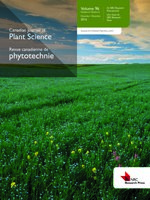Harker, K. N., O'Donovan, J. T., Blackshaw, R. E., Johnson, E. N., Lafond, G. P. and May, W. E. 2012. Seeding depth and seeding speed effects on no-till canola emergence, maturity, yield and seed quality. Can. J. Plant Sci. 92: 795-802. Canola seed costs are substantial, but only a relatively small proportion of planted seeds actually emerge as seedlings. Direct-seeded (no-till) experiments were conducted from 2008 to 2010 at four western Canada locations [Lacombe AB (2007-2010), Lethbridge AB, Indian Head SK, and Scott SK] to determine the influence of cultivar (hybrid vs. open-pollinated), seeding speed (6.4 vs. 11.2 k h-1), and seeding depth (1 vs. 4 cm) on the emergence, maturity, yield, and seed quality of glyphosate-resistant canola. Canola emergence density was positively associated with precipitation levels surrounding the time of seeding; other site and environmental predictors such as soil temperature, soil texture, soil organic matter, latitude and longitude did not consistently influence canola emergence density. The agronomic performance of hybrid canola, including seed yield and quality, was usually superior to open-pollinated canola, but there was no difference in emergence density between the two cultivars. However, the hybrid cultivar emerged 1 d earlier, grew faster and covered the ground more quickly than the open-pollinated cultivar; important results from a crop-weed competition standpoint. Although seeding depth did not influence average canola yield, it often had a major impact on canola emergence density. Under moist conditions, average canola emergence improved from 37 to 62% as seeding depth decreased from 4 to 1 cm, respectively. Seeding at a depth of 1 vs. 4 cm also decreased days to emergence, increased canola ground cover, decreased days to flowering and days to maturity and tended to decrease green seed levels. Relatively high canola emergence rates can reduce the need for additional herbicide applications, herbicide input costs and selection pressure for herbicide resistance. Relatively high canola stand densities can improve the ability of canola to successfully tolerate and accommodate biotic and abiotic stress.
How to translate text using browser tools
1 July 2012
Seeding depth and seeding speed effects on no-till canola emergence, maturity, yield and seed quality
K. N. Harker,
J. T. O'Donovan,
R. E. Blackshaw,
E. N. Johnson,
G. P. Lafond,
W. E. May
ACCESS THE FULL ARTICLE
It is not available for individual sale.
This article is only available to subscribers.
It is not available for individual sale.
It is not available for individual sale.

Canadian Journal of Plant Science
Vol. 92 • No. 4
July 2012
Vol. 92 • No. 4
July 2012
canopy cover
Couverture végé tale
direct-seeding
frost
gel
graines vertes
green seed




